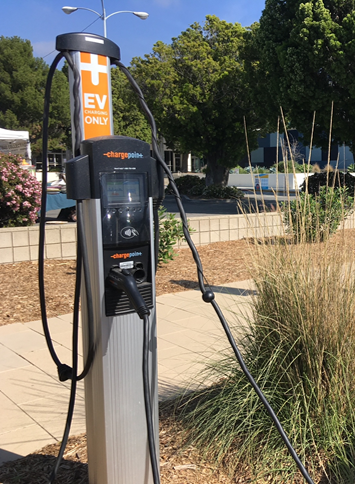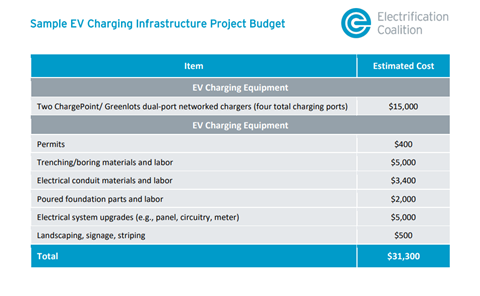Federal Funding Guidance for Cities
The federal government is providing new funding sources for electric vehicles (EVs) and charging infrastructure. Municipalities can set themselves up to take advantage of these opportunities.
Advanced research and planning will prepare local governments to develop successful applications for federal funds that will accelerate the widespread adoption of EVs within their organizations and the communities they serve. The Electrification Coaliton provides support and resources to help cities maximize these opportunities.

Key Legislation
New federal funding for EVs and charging infrastructure was enacted in November 2021 through the Bipartisan Infrastructure Law. Additional funds are available through existing federal and state programs.
- Bipartisan Infrastructure Law: President Biden signed the law on Nov. 15, 2021. This legislation includes funding for the replacement of thousands of deficient transit vehicles, including buses, with zero-emission vehicles. It will also invest $7.5 billion to build out a national network of EV chargers along highway corridors and within communities. The federal government will distribute the charging infrastructure funding through the following programs:
- National Electric Vehicle Infrastructure Formula Program: $5 billion over the next five years.
- Charging and Fueling Infrastructure Grant Program: $2.5 billion over the next five years.
- Efforts are underway in Congress to develop reconciliation legislation for funding for EV purchase incentives, charging infrastructure, federal fleet electrification, EV manufacturing tax credits, diesel emissions reductions, zero-emission equipment and technology at ports, air quality improvements, and related transportation electrification priorities.
- Other Funding Opportunities: To explore existing federal and state programs that provide funding for transportation electrification, search the EC’s EV Laws and Incentives search tool, which pulls from the U.S. Department of Energy’s continually updated database.
Applying for Infrastructure Funding
Eligible applicants for the National Electric Vehicle Infrastructure Formula Program include states, local governments, metropolitan planning organizations, port authorities and Indian tribes.
National Electric Vehicle Infrastructure (NEVI) Formula Program Eligibility Requirements
The NEVI Program requires a deployment plan submission to the Joint Office of Energy and Transportation for a successful application submission by Aug. 1, 2022.
- Projects must include a detailed plan for the deployment of electric vehicle supply equipment (EVSE).
- Projects must be located along designated Federal Highway Administration (FHWA) alternative fuel corridors.
Charging and Fueling Infrastructure Grant Program
This program will prioritize rural areas and other historically disadvantaged communities.

Project Proposal Checklists
Completing federal funding applications can be overwhelming. Use the checklists below to help make the process more manageable, to evaluate the feasibility of your project, and to ensure that your application is thorough, compelling, and ultimately successful.
- Project checklist and timeline: EV charging infrastructure
- Sample EV charging infrastructure project budget, based on our experience with cities across the country
- Project checklist and timeline: Fleet electrification.

Tips for a Successful Proposal
- Create a realistic timeline that allows for thoughtful analysis, detailed project planning, robust stakeholder engagement, internal application reviews, multiple rounds of edits, and city leadership approval (see project checklists above for sample timelines).
- For charging infrastructure projects, describe in your deployment plan the various barriers your organization or community faces related to the expansion of EV charging networks and EV adoption. Articulating these barriers can help in equity analysis for priority projects.
- Once the application is 90-95% complete, consider conducting a “red team” review by staff not affiliated with the project to assess the strength of the application and identify any gaps or opportunities for improvement.
- Allow time to obtain any supporting documents from third parties (e.g., site plans, vendor quotes, letters of support).
- Never plan to submit your application on the day of the deadline! Technical problems with websites or other surprises can always arise, so don’t let all your hard work get derailed.
Tools, Information, and Resources
Use the following resources for additional help in planning your project and applying for funding.
- EV Laws and Incentives Database: Searchable database that contains federal and state laws and incentives related to EVs and charging infrastructure.
- Letters of support: Reach out to the EC team to obtain a letter of support to strengthen your application.
- EV Funding and Financing Guide: Our comprehensive guide on identifying electrification funding and financing options, including federal, state, local, and utility programs, legal settlements, state or regional carbon market revenues, future operational savings, monetization of vehicle-to-grid capabilities, and more.
- Build Back Better EV Fact Sheet: Our fact sheet details the transportation electrification policies and funding in the Build Back Better Act, as passed in the U.S. House of Representatives in November.
- Dashboard for Rapid Vehicle Electrification (DRIVE Tool): A Microsoft Excel-based tool that provides quick and easy analysis for light-, medium-, and heavy-duty fleet electrification. The DRVE Tool can evaluate a variety of procurement ownership structures, vehicle types, electric vehicle charging configurations, and many more scenarios.
- Climate Mayors EV Purchasing Collaborative: Reduces hard and soft costs of EV procurement for public-sector fleets via cooperative purchasing.
- Philadelphia’s Municipal Clean Fleet Plan: The City of Philadelphia developed its Clean Fleet Plan to outline a pathway to carbon neutrality by 2050.
- Municipal Fleet Electrification – A Case Study of Charlotte, N.C.: Explore the fleet electrification plans, successes, and lessons learned from a leader among American cities.
